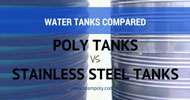
One of the most popular tank choices today are polyethylene (poly) water tanks. Another choice you will likely come across when deciding upon a rainwater tank are stainless steel tanks.
Before comparing important differences between poly and stainless steel water tanks, it is important to understand that there are different grades of stainless steel. Grades are often represented by different numbers. For example, 304 Stainless Steel is often what you find in your kitchen sink. If the stainless steel in being used in marine environments then a higher grade of 316 Stainless Steel would be used.
Chromium is a base element found in stainless steel that prevents corrosion. To resist the corrosive effects of salty sea water, harsh acids and the like, the chemical element molybdenum needs to also be added. Molybdenum is found in the 316 Stainless Steel and is used in surgical instruments and stainless steel implants.
Unless specially requested, at greater expense, 304 Stainless Steel (or less), will likely be used in a stainless steel rainwater tank. Always confirm first with the supplier what grade of stainless steel they use before purchasing. If you are not familiar with stainless steel grades, then just research the grade of steel online by typing it into a search engine.
Below we compare key important differences between poly water tanks and stainless steel tanks, including how long it will last, strength, maintenance, installation and price.
Ease of Installation
Firm foundations are ideal for all tanks, however bases can often consist of crusher dust for poly tanks. Stainless steel tanks require more compact and solid foundations due to their construction.
It is important to ensure your foundations are protected from erosion. Once a stainless steel tank is installed however, you do not want to move it again. Not only is it heavy, but you risk compromising its structural integrity and having leaks develop.
Poly water tanks on the other hand are much lighter and easier to set in place. If you also decide to re-locate your tank later on, then a poly water tank is much easier to move.
Longevity
Poly water tanks can last a long time, up to 20 years or more. The material can withstand the harsh effects of the Sun due to UV-stabilisers added to the moulding mix. Just like how adding chromium to steel can protect it from rust, so too UV-stablisers being added to a polymer mix prevents the plastic from becoming brittle and decomposing.
With stainless steel tanks it is important to keep them clean with a cloth and fresh water. Keep solvents away which might cause corrosion such as salty sea water or chlorine found in pools.
Do not bury your stainless steel tank at all. High industrial areas and welding can also leave iron deposits that can cause irreversible pitting and even result in your stainless steel tank leaking.
Keep in mind corrosion often occurs at the joints, rivets or screws. Incorrect welding can neutralise the protective element in the stainless steel allowing rust and corrosion to occur.
There are reports of stainless steel tanks leaking within two years due to poor manufacturing, so it is important to do your homework.
Warranty
Stainless steel tank warranties differ, but a quality stainless steel tank should carry a high warranty in terms of its steel. Keep in mind the weak point with the stainless steel tank is often with how they are manufactured or the sheets are joined together.
While warranties for the stainless steel tank can be found for 30 years and more, the actual manufacturing of the tank is often half that. While your stainless steel tank can last more than 15 years, we have seen reports of some stainless steel tanks leaking within 2 years due to corrosion of rivets or screws joining the corrugated sheets together.
As for poly water tanks, they can carry a warranty of up to 25 years. Based upon warranties alone, rather than the actual product, warranties for a quality polymer water tank probably provide greater peace of mind than that of a stainless steel tank.
Maintenance
Poly tanks require much less ongoing expense to maintain, and can be setup with a tank self-cleaning system. A special easy-to-install pipe with special holes is placed inside the tank and connected to the water tank overflow. Whenever your tank is full of water all the debris at the bottom of the tank gets sucked into the pipe and expelled from your tank.
To keep your rainwater fresh in a stainless steel tank often requires a more expensive two-tank system. Rainwater falls into the first tank which contain a coarse filter screen within. The water falls through the screen, and the debris gets trapped and discharged out the side of the tank. This filtered water is then pumped through a finer filter before being pumped into a second stainless steel water tank. This ensures your water always remains clean and fresh tasting.
Water Quality
Poly and stainless steel water tanks provide equally quality water.
Keep in mind that in stainless steel rivets and screws can corrode and pollute your drinking water. An investigation by the Public and Environment Health Services in Tasmania even found water in some stainless steel tanks containing harmful levels of lead.
Poly water tanks manufactured from food-grade polyethylene provides the purest quality water and often at much cooler temperatures.
Strength
Stainless steel tanks are very strong and will not bulge or warp since they are made from steel. Being metal however, they are less impact resistant than a poly tank which will easily withstand being struck with a hammer.
A weak point with stainless steel tanks are again in how it has been manufactured. That is, how the stainless steel sheets have been joined together and attached to the base.
Poly tanks are also very strong. If properly designed and manufactured according to Australian standards for poly tanks then bulging and warping should never happen. Some features of a strong and quality poly tank include:
- It being moulded as one seamless piece (that is, without side seams)
- Wall thickness being of 4.5mm or greater
- Strong base corners with a radius of 25mm for a tank up to 1.8m in diameter, or a radius of 38mm for tanks over 1.8m in diameter.
- Tapered tanks walls (thicker poly walls at the base of your tank where the most pressure will be)
- Ribs which provide greater strength.
Additional requirements for building a strong poly tank are found in the Australian poly tank standard, AS/NZS 4766 Polyethylene storage tanks for water and chemicals.
Note: Not all Australian poly water tanks comply with this standard. Always confirm your tank is certified by asking the manufacturer who certified them and for their certification number.
Size
Stainless steel tanks can be manufactured to higher capacities than poly tanks, and often used for different purposes. Whereas poly tanks can be made to reliably store water up to around 50,000 litres, stainless steel tanks can be constructed to store up to around 250,000 litres. That said, poly tanks can be coupled together to provide a combined capacity.
Style
Stainless steel tanks come in different finishes, but do not offer a selection of colours to choose from. Many poly water tanks, offer a range of COLORBOND® colours.
Steel tanks can often be specially constructed if need be, as can poly water tanks. Each have comparable shapes, your traditional round and slimline.
Poly tanks offer greater versatility however, offer tank options that can be placed under a deck and or underground. You will not find stainless steel tank options in these categories.
Price
Poly tanks are much cheaper to buy than a stainless steel tank. Approximately 50% cheaper, but this is dependent upon size, type and brand of tank purchased.
Team Poly Water Tanks
Team Poly are experts in manufacturing poly products. Our range includes rainwater tanks, industrial tanks and farming products. If you have found this article helpful, why not contact us today to discuss your needs.

